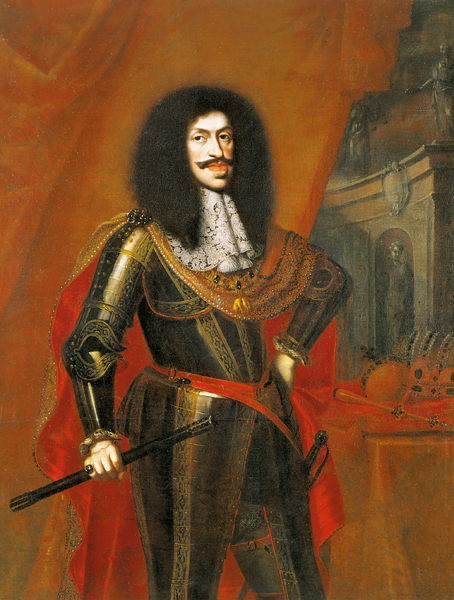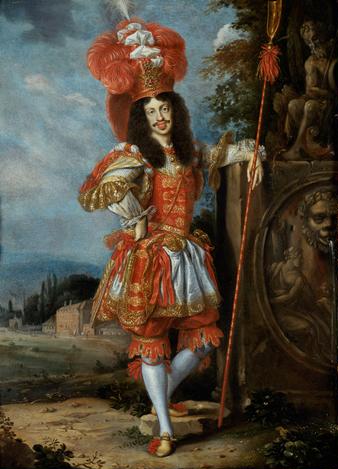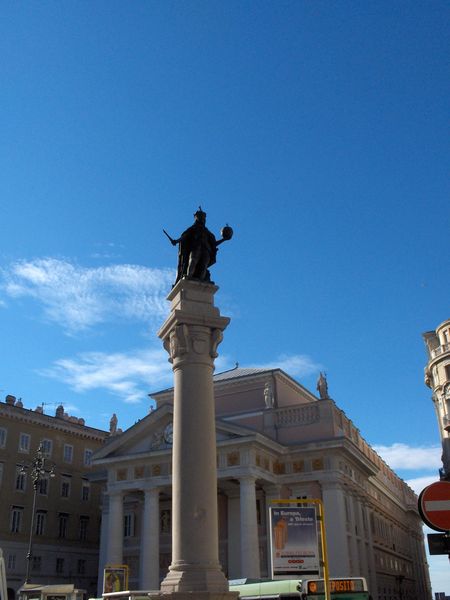<Back to Index>
- Chemist Hermann von Fehling, 1812
- Painter Pieter Jansz. Saenredam, 1597
- Holy Roman Emperor Leopold I, 1640
PAGE SPONSOR



Leopold I (name in full: Leopold Ignaz Joseph Balthasar Felician; Hungarian: I. Lipót) Habsburg (9 June 1640 – 5 May 1705), Holy Roman Emperor, King of Hungary, King of Bohemia, was the second son of the emperor Ferdinand III and his first wife Maria Ana of Austria. His maternal grandparents were Philip III of Spain and Margaret of Austria. He was also a first cousin of his rival, Louis XIV of France.
He became heir apparent on
9 July 1654 by the death of his elder brother Ferdinand IV, and reigned
as Holy Roman Emperor from 1658 to 1705. Leopold's reign was marked by
military successes against the Ottoman Empire in the Great Turkish War through his greatest general Prince Eugene of Savoy, including at Saint Gotthard, Vienna, Second Mohács and Zenta. By the end of the war, the Habsburg Monarchy had annexed Transylvania and much of Hungary. Leopold is also known for his conflicts against France through the Nine Years' War and the War of Spanish Succession. In the latter, he had hoped to enforce the Second Partition Treaty, which assigned the throne of the Kingdom of Spain to his son the Archduke Charles. Leopold managed the war extremely well, and the Habsburg Monarchy scored decisive victories at Schellenberg and Blenheim. His death in 1705 left the throne to his eldest son Joseph. He was a younger brother of Ferdinand IV of Hungary and Mariana of Austria.
Intended for the Church, he received a good education but his prospects
were changed by the death of his elder brother Ferdinand IV, on 9 July
1654 of smallpox, when he became his father's heir. Leopold was
physically unprepossessing. Short and sickly, he had inherited the Habsburg lip to a degree unusual even in his family. Historian William Coxe described
Leopold in the following manner: "His gait was stately, slow and
deliberate; his air pensive, his address awkward, his manner uncouth,
his disposition cold and phlegmatic." In 1655 he was chosen king of Hungary, in 1656 king of Bohemia, in 1657 he gained the crown of Croatia. In July 1658, more than a year after his father's death, he was elected emperor at Frankfurt in spite of the intrigues of Cardinal Mazarin, who wished to place on the imperial throne Ferdinand Maria, Elector of Bavaria or some other prince whose elevation would break the Habsburg succession. Mazarin, however, obtained a promise from the new emperor that he would not send assistance to Spain, then at war with France, and, by joining a confederation of German princes, called the League of the Rhine, France secured a certain influence in the internal affairs of Germany. Leopold's long reign covers one of the most important periods of European history; for nearly the whole of its forty-seven years he was pitted against Louis XIV of France,
whose dominant personality completely overshadowed Leopold. The emperor
was not himself a man of war, and never led his troops in person; yet
the greater part of his public life was spent in arranging and
directing wars. The first was with Sweden, whose king Charles X found a useful ally in the prince of Transylvania, György II Rákóczi, a rebellious vassal of the Hungarian crown. This war, a legacy of the last reign, was waged by Leopold as the ally of Poland until peace was made at Oliva in 1660. A more dangerous foe next entered the lists. The Ottoman Empire interfered in the affairs of Transylvania, always an unruly district, and this interference brought on a war with the Holy Roman Empire, which after some desultory operations really began in 1663. By a personal appeal to the diet at Regensburg Leopold
induced the princes to send assistance for the campaign; troops were
also sent by France, and in August 1664, the great imperialist general, Raimondo Montecuccoli, gained a notable victory at Saint Gotthard. By the Peace of Vasvár the
emperor made a twenty years' truce with the sultan, granting more
generous terms than his recent victory seemed to render necessary. After a few years of peace began the first of three wars between France and the Empire. The aggressive policy pursued by Louis XIV towards the United Provinces had aroused the serious attention of Europe,
and steps had been taken to check it. Although the French king had
sought the alliance of several German princes and encouraged the Turks in their attacks on Austria the
emperor at first took no part in this movement. He was on friendly
terms with Louis, to whom he was closely related and with whom he had
already discussed the partition of the lands of the Spanish monarchy;
moreover, in 1671, he arranged with him a treaty of neutrality. In 1672, however, he was forced to take action. He entered into an alliance for the defence of the United Provinces during the Franco-Dutch War; then, after this league had collapsed owing to the defection of the elector of Brandenburg, the more durable Quadruple Alliance was formed for the same purpose, including, besides the emperor, the king of Spain and several German princes, and the war was renewed. At this time, twenty-five years after the peace of Westphalia,
the Empire was virtually a confederation of independent princes, and it
was very difficult for its head to conduct any war with vigour and
success, some of its members being in alliance with the enemy and
others being only lukewarm in their support of the imperial interests.
Thus this struggle, which lasted until the end of 1678, was on the
whole unfavourable to Germany, and the advantages of the Treaty of Nijmegen were with France. Almost immediately after the conclusion of peace Louis renewed his aggressions on the German frontier through the Réunions policy. Engaged in a serious struggle with the Ottoman Empire, the emperor was again slow to move, and although he joined the Association League against France in 1682 he was glad to make a truce at Regensburg two years later. In 1686 the League of Augsburg was formed by the emperor and the imperial princes, to preserve the terms of the treaties of Westphalia and of Nijmegen. The whole European position was now bound up with events in England, and the tension lasted until 1688, when William III of Orange won the English crown through the Glorious Revolution and Louis invaded Germany. In May 1689, the Grand Alliance was formed, including the emperor, the kings of England, Spain and Denmark, the elector of Brandenburg and
others, and a fierce struggle against France was waged throughout
almost the whole of western Europe. In general the several campaigns
were favourable to the allies, and in September 1697, England, Spain
and the United Provinces made peace with France at the Treaty of Rijswijk. To
this treaty, Leopold refused to assent, as he considered that his
allies had somewhat neglected his interests, but in the following month
he came to terms and a number of places were transferred from France to
Germany. The peace with France lasted for about four years and then
Europe was involved in the War of the Spanish Succession. The king of Spain, Charles II,
was a Habsburg by descent and was related by marriage to the Austrian
branch, while a similar tie bound him to the royal house of France. He
was feeble and childless, and attempts had been made by the European
powers to arrange for a peaceable division of his extensive kingdom.
Leopold refused to consent to any partition, and when in November 1700
Charles died, leaving his crown to Philippe de France, Duke of Anjou, a grandson of Louis XIV, all hopes of a peaceable settlement vanished. Under the guidance of William III a
powerful league, a renewed Grand Alliance, was formed against France;
of this the emperor was a prominent member, and in 1703 he transferred
his claim on the Spanish monarchy to his second son, Charles.
The early course of the war was not favorable to the imperialists, but
the tide of defeat had been rolled back by the great victory of Blenheim before Leopold died on 5 May 1705. In
governing his own lands Leopold found his chief difficulties in
Hungary, where unrest was caused partly by his desire to crush Protestantism. A rising was suppressed in 1671 and for some years Hungary was treated
with great severity. In 1681, after another rising, some grievances
were removed and a less repressive policy was adopted, but this did not
deter the Hungarians from revolting again. Espousing the cause of the
rebels the sultan sent an enormous army into Austria early in 1683;
this advanced almost unchecked to Vienna, which was besieged from July to September, while Leopold took refuge at Passau. Realizing the gravity of the situation somewhat tardily, some of the German princes, among them the electors of Saxony and Bavaria, led their contingents to the imperial army which was commanded by the emperor's brother-in-law, Charles, duke of Lorraine, but the most redoubtable of Leopold's allies was the king of Poland, John Sobieski, who was already dreaded by the Turks. He
also expelled Jewish communities from his realm, for example the
Viennese Jewish community, which used to live in an area called "Im
Werd" across the Danube river. After the expulsion of the Jewish
population, with popular support, the area was renamed Leopoldstadt as a thanksgiving.
On 12 September 1683, the allied army fell upon the enemy, who was completely routed, and Vienna was saved. The imperial forces, among whom Prince Eugene of Savoy was rapidly becoming prominent, followed up the victory with others, notably one near Mohács in 1687 and another at Zenta in 1697, and in January 1699, the sultan signed the treaty of Karlowitz by which he admitted the sovereign rights of the house of Habsburg over nearly the whole of Hungary (including Serbian Vojvodina). As the Habsburg forces retreated, they withdrew 37,000 Serb families under Peć Patriarch Arsenije III Čarnojević.
In 1690 and 1691 Emperor Leopold I had conceived through a number of
edicts the autonomy of Serbs in his Empire, which would last and
develop for more than two centuries until its abolition in 1912. Before
the conclusion of the war, however, Leopold had taken measures to
strengthen his hold upon this country. In 1687, the Hungarian diet in Bratislava (called Pressburg at
that time) changed the constitution, the right of the Habsburgs to
succeed to the throne without election was admitted and the emperor's
elder son Joseph I was crowned hereditary king of Hungary. During this reign some important changes were made in the constitution of the Empire. In 1663, the imperial diet entered upon the last stage of its existence, and became a body permanently in session at Regensburg. In 1692, the duke of Hanover was raised to the rank of an elector, becoming the ninth member of the electoral college. In 1700, Leopold, greatly in need of help for the impending war with France, granted the title of king in Prussia to the elector of Brandenburg.
The net result of these and similar changes was to weaken the authority
of the emperor over the members of the Empire and to compel him to rely
more and more upon his position as ruler of the Austrian archduchies
and of Hungary and Bohemia. Leopold was the first to have realized this
altered state of affairs and to have acted in accordance with it. Leopold
was a man of industry and education, and during his later years, he
showed some political ability. Regarding himself as an absolute
sovereign, he was extremely tenacious of his rights. Greatly influenced
by the Jesuits, he was a staunch proponent of the Counter-reformation. In person, he was short, but strong and healthy. Although he had no
inclination for a military life, he loved exercise in the open air,
such as hunting and riding; he also had a taste for music and composed
several Oratorios and Suites of Dances. Leopold was married three times. In 1666, he married Margaret Theresa of Spain (1651 – 1673), daughter of King Philip IV of Spain, who was both his niece and his first cousin. She was the blonde princess depicted in Diego Velazquez' masterpiece "Las Meninas".
The wonderful series of Velazquez portraits of this lovely Spanish
princess at various stages of her childhood were sent from the court of
Madrid to Leopold as he waited in Vienna for his fiancee to grow up.
This beautiful girl, the representation of merry childhood, was married
at fifteen. She gave birth to four children and finally died at the age
of twenty-one, leaving Leopold heartbroken, as he had truly loved her. His second wife was Archduchess Claudia Felicitas of Austria,
the heiress of Tyrol. She died at the age of twenty-two on 2 September
1676; their two daughters also died. She was buried in the crypt of the
St. Dominic side chapel of the Dominican church in Vienna. His third wife was Eleonore of Neuburg, a princess of the Palatinate. They had ten children.
Due
to an extreme interbreeding among his progenitors, the hereditary
Habsburg jaw was most prominent in Leopold. Because his jaw was
depicted unusually large on a 1670 silver coin, Leopold was nicknamed
"the Hogmouth". However, most collectors do not believe the coin was an
accurate depiction.